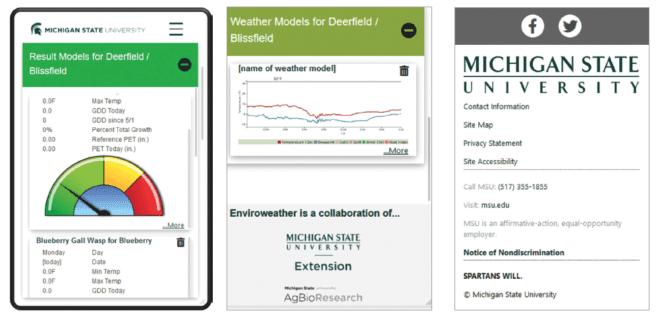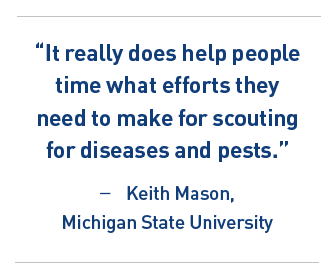

May 31, 2019Michigan upgrades, expands weather station network
Michigan growers can look for a better, and slightly bigger, version of Enviroweather to be at their fingertips.
Enviroweather, Michigan’s network of weather stations and modeling tools, next year will feature a new website design that’s more accessible from mobile devices. In short, it will be better suited for use at 4 a.m. from a pickup truck cab parked out in the middle of the farm.
The current incarnation of Enviroweather (www.enviroweather. msu.edu) is functional, but not intuitive.


“It’s not straightforward and easy to use for someone who doesn’t use it every day,” said Keith Mason, Enviroweather coordinator for Michigan State University (MSU). “Over half of the times that someone accesses Enviroweather, it’s from a phone or a tablet. Technology has changed.”
The new Enviroweather website will still be browser-based (rather than an app) but it will feature a login and personalized dashboard for each grower who creates a free account. The dashboard will allow users to save weather stations, crop models and weather tools for easy access. The new website is also designed for viewing on smartphones and tablets. A beta version of the new website will be out in 2019, with training expected this summer and fall and the entire site functional for the 2020 growing season. Training webinars will be announced via MSU Extension eNews Updates. The current Enviroweather website will remain online until the new website is released.
Enviroweather features models for growers to predict and monitor what is happening with their crops based on their farm location, weather data and mathematical models developed by researchers. Michigan’s Enviroweather collaborates with other regional weather networks such as Cornell University’s Network for Environment and Weather Applications.
Vegetable growers can pull up current guidance on insect pests and diseases of asparagus, snap beans, cole crops, sweet corn, cucurbits and potatoes. Fruit growers have more crops and mathematical models available to them, including tools for calculating irrigation, apple maturity and carbohydrate apple thinning – that last model through collaboration with Cornell University.
This resource is a far cry from consulting an almanac and writing down your schedule on a paper calendar, and that’s the goal – smarter, better-informed growing. Growers can better plan their scouting and spraying work based on a wide variety of weather data and research-based math models.


Mason, who took his current job in September 2018, has nearly 20 years of experience in MSU’s Department of Entomology during which he coordinated several multi-state, on-farm research projects working with growers in grapes and blueberries.
The raw weather data comes from a network of 96 Campbell Scientific research-grade weather stations linked to a central database on Michigan State’s main campus in East Lansing. Users can access the data over the internet at enviroweather.msu.edu to run weather-based predictive models for crop management on their farms. Enviroweather recently completed the installation of eight new weather stations in the west central region of Michigan in Oceana County and on Michigan’s Fruit Ridge that will provide additional detailed weather data, in a powerhouse area for tree fruit and vegetable production in west Michigan.
The old website had mathematical models that were “hard-coded” into the website for calculating results from the weather data. The new Enviroweather website will have all the functionality of the old website but in an easier-to-access format.
“I think a lot of it was geared to our Extension educators and they would relay information to growers,” Mason said. That grower-Extension agent relationship can continue, “but this should also make it easier for growers to save their information and save their preferences.”
Personalized dashboards should also make it easier for direct use by the growers.
“It’s really just an area where your settings are on the website,” Mason said. “For the new website, what we’re going to recommend is that people set up a free account just with email, and using that way to access it, they’ll be able to save whatever weather stations they look at, whatever crops they’re interested in, and the particular models they need to know about for that particular time of year.”
The task now, for Mason and his team, is moving the complex, research-based mathematical models into a beta version of the new website.
The group first tackled the most complex of the models – an interactive tool for predicting fire blight spread – with the idea of applying what they learn from that task to the other parts of the website.
“We’re very much in the development stage of it now,” Mason said.
– Stephen Kloosterman, associate editor
Above, screenshots show what the new Enviroweather website will look like. The redesign is geared toward use by growers from phones and other mobile devices. Photos: Keith Mason














